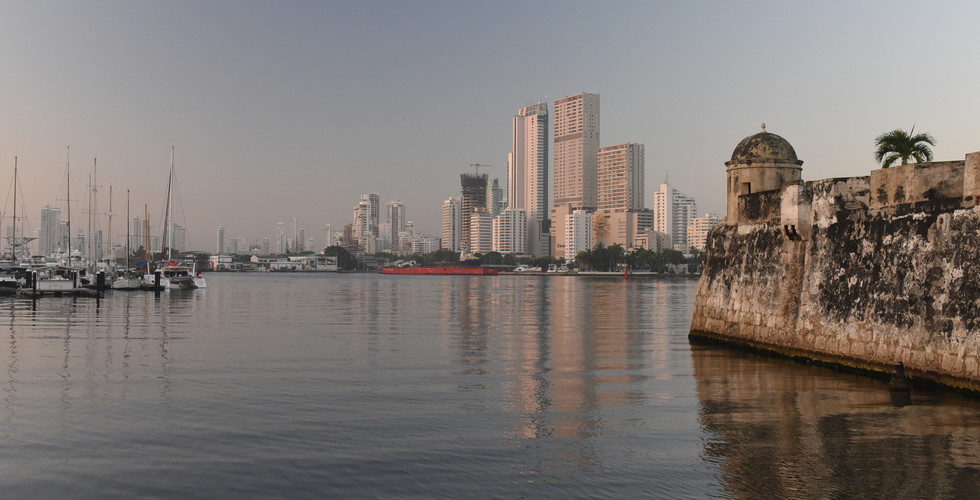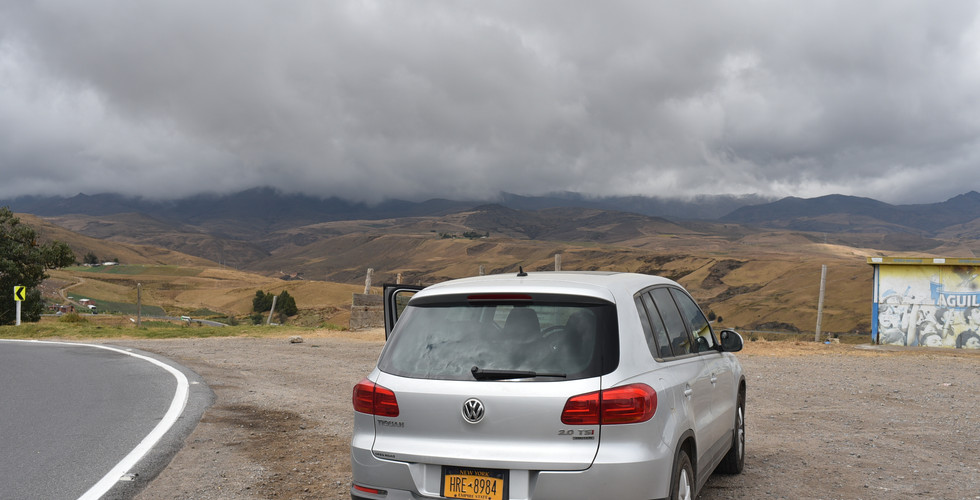Vamos, Colombia!
- Timon van den Berg
- Mar 23, 2019
- 9 min read
It has been a while, since we’re driving down south and not flying, but we are lounging at the airport again. I developed this skill which I called “airport hanging”, but honestly I didn’t miss it at all. A late afternoon flight brought us from Panama City to Cartagena, Colombia in roughly an hour. Tipped by our container buddies, we found a really cheap flight with a company called Wingo. For the first time in my life I set foot in South America. The customs check at the airport was smooth, and in comparison to many other countries it was free to enter and they were friendly. Funny for us, when we arrived we parked next to a large KLM plane which was boarding to leave for Amsterdam. I think that was the closest we have been to the Netherlands for quite a while.
Cartagena is actually very expensive, compared to Central America and the rest of the country. It’s the number one tourist destination in Colombia, and you will find a fair amount of foreign and local tourists there. For us, the main order of business was to get our car back. If you start in the early morning, it’s a two day process. Due to the fact that offices close at separate times, or some are only open in the mornings, it’s close to impossible to get you car out the same day as you start the process. The main thing you have to do is wait, pay and provide copies of documents. But, with 35 degrees this is a tough job, and since I was the only one allowed in the harbor, Hester could spend her time relaxing at the pool of the hotel. Anyway, after two days of waiting from 8:00 to 16:00 in the afternoon, we got our beloved car back. Driving it out of the port in Cartagena was a great feeling, and it felt like the start of a new phase in our adventure.
Since we weren’t sure about the time it would take for us to get the car out, we booked 5 nights in Cartagena. We only twice visited the old town, which is basically an old Spanish city. It has a lovely ambiance, and some good restaurants and squares where you can enjoy your coffee or dinner. At night the rum finds its ways to the tables, and local street performances take care of the live entertainment. Let me summarize it as being a very touristy town, but well worth visiting since its very pretty. On the first night in town Hester decided to break here Havaianas, and was forced to walk a part on bare feet. But it was almost like the slippers knew where to break, since we were literally around the corner of the Havaiana store. So, with a new pair of Havaianas we were able to continue our stroll through the town. Since it was our first night after we got the car back, we decided to celebrate the transfer from Central to South America at a nice restaurant, where they served local farmer to table dishes. After dinner we strolled back to the hostel enjoying the impressive amount of Christmas lights still hanging all over the city.
Both of the times we visited the old town, we forgot to bring the camera. Since Hester didn't want to leave without documenting this beautiful city, she decided to wake up at 5:30 am, and walk into the old town before leaving Cartagena. With the light of the sunrise, the town even looked more impressive. And the biggest plus of walking around Cartagena so early in the morning? There's no one on the streets, you'll have the whole old town to yourself!
Leaving Cartagena, actually really felt like we were starting a new adventure. That morning our container buddies had left the same hotel as well, and went in a similar direction as us. But since they were able to sleep in their car, their travel schedule was slightly different than ours. Soon we noticed that the roads were different then we were used to. Also, the houses and the way things worked were just new and not really comparable with what we had seen in Central America. Shortly after leaving the city we were faced with a big downside of traveling through Colombia by car. Almost every road is a toll road, and during our stay in Colombia we spent more than 200 USD in toll. Benefit of this is that typically the quality of the road is very good, so every downside has its upside, I guess. After 3 hours we arrived in Santa Marta, and we would actually just stay in a town north of Santa Marta, on the coast. On the way into the town we had to show proof of our hotel reservation to the police. During this time of the year, the town was flooded by tourists who take the boat from here to Tayrona National Park. Since the road is a dead end, it changes into a big traffic mess quite fast, even with the police filtering out the tourists.

We had quite a relaxing time here, since we didn’t really schedule anything, and I was recovering from the flu. Therefor we only spent one day in the National Park. We actually traveled by car to one of the better beaches on the west side of the park. Although the beach is very popular, it’s not really easy to reach. The last 10km are a sand road, which made the trip feel like we were in a sandstorm. Due to the fact that also Colombians have vacation, the beach was crowded, and to reach the parking there was even a traffic jam like you have in Zandvoort on a nice summer day. At the beach we decided to fully mingle in with the locals, and we rented ourselves a cabana with beach view and lounged in our beach chairs. Every 2 minutes a sales person came by to ask whether we needed cocktails or food. Around lunch time trucks loaded with food were delivering meals to people who placed the lunch order earlier that day. The beach itself wasn’t very nice, but the water was blue and the people were friendly as always, so that did the trick for an enjoyable afternoon.
It’s time to leave the Colombian beach behind us, we have no intention of visiting it again during this trip, so for now goodbye! Our next destination El Cocuy National Park. A Colombian destination which is definitely not on everyone’s travel itinerary, because it's very complicated to reach. But, in this case we experience the real benefit of having our own car, which gives us maximum flexibility. Google Maps has told us it will take us roughly 18 hours to reach, so we decide to split the trip in three days. First task of the day is to find gas. Since so many people come to the region for their holidays, gas stations are without gas. But, we are early and we find a station that has been refilled overnight. The road is small, and it’s a game of overtaking, since it’s only two lanes and there are many slow trucks. About 4 hours in, I spot our container buddies. We didn’t speak to them anymore after we left Cartagena, so it’s a 100% coincidence that we meet them there. They are traveling partly the same route, but with a different destination. As said, El Cocuy isn't on everybody's list, since its very remote. The first day we make it to a town called Aguachica. There’s nothing there except for a police stop, who decided to pull us from the road for a thorough check of our documents. In the end all good, and we shake hands like we’re buddies. The next day we would see the Andes for the first time. The route brings us to over 3000 meters, and we find hundreds of Venezuelan people walking alongside the road. When we reach Pamplona around 2 pm, we had enough and decide to go look for a hotel. It’s actually cold here! It has been a while that we were cold. I think our last cold night was in Yellowstone national park in the Roosevelt Lodge, which is more than 6 months ago. Surprisingly enough, nobody here in town has any kind of heating, even though it’s only 6 degrees, all the doors and windows are open everywhere. The next morning when we leave Pamplona, we are happy we stopped. The final stretch to El Cocuy isn't completely paved and this day we spent a good 8 hours on the road. Our altitude meter reaches 3900 meters at some point during the trip, definitely the highest point of our trip so far. After 22 hours in the car we reach the town of Guican. The town is located at an altitude of 2800 meters, and again nobody has any kind of heating! Brrr..
The next morning we start with arranging our hike in the El Cocuy National Park. The national park obligates you to have a guide, and a mandatory park insurance. This insurance will cover you in case they need to rescue you from the mountain. After arranging the insurance and finding ourselves a guide, we are invited by the park ranger to watch the obligated security instruction movie. It starts to feel like we are going to experience a serious hike tomorrow! Later in the afternoon we make a quick trip to the town of El Cocuy. In a small, local shop we buy some chocolate and sunscreen. But the lady behind the counter doesn't really understand which chocolate I want, so she decides to invite me behind the counter to grab it myself. Stocked up with supplies for our trip tomorrow, we go back to our hotel. Tomorrow the alarm has been set for 3:30 am, so we sleep in early.
4:00 am the next morning we drive of to the National Park. The road to the entrance of the park is narrow, and takes us roughly an hour. Of course there is no pavement, so it’s fairly bumpy. At 3500 meters we arrive at base camp. Our insurance and entrance tickets are checked, and we need to confirm that we meet up with a guide. We booked a package, which means that we are served breakfast at the base camp prior to departing for the hike. Only the breakfast is already a nice experience. There are long tables filled with Colombians, who are all enjoying their breakfast prior to starting the climb to the glacier. Since we are the only foreigners here, we were quickly approached by someone who wanted to know where we are from, and how we managed to get all the way to El Cocuy in our New York plated car. After breakfast it was time to start our 1100 meter climb to the glacier. It’s not as easy as I was expecting. We haven’t been very active the last couple of weeks and the higher altitude ain’t helping either. Around 10:30 we reach the top. Hester decides to stay here at 4600 meter in the sun, I take a brief rest with the guide to travel further to the glacier. The glacier isn’t that much higher, but it’s another 30 minutes one way. I could try to describe the view, but I think you can better see the pictures for yourself! :-). Around noon we head back to the base camp. This actually goes pretty quick, but the last hour is killing us. We both have some serious issues with the higher altitude and drinking water doesn’t work anymore. A serious headache is bothering both of us, which took until the next morning to actually feel better. Learning our lesson about altitudes, we will prepare even better the next time. The hike was definitely one of the most beautiful ones we ever did! At base camp we rested a little, and again we were approached by locals who wanted to know how we managed to travel all the way in our New York plated car to El Cocuy. There is even one guy who decides to make us an offer to buy the car from us :-O.
It’s time to leave this remote place after an amazing hike, which was definitely a highlight of our trip so far. Next destination Bogota! It took us again 8 hours to travel from El Cocuy to Bogota, but this time the road actually contained some highways which makes traveling a little more convenient when you have to drive these longer distances. Overall, the roads in Colombia are pretty good, but man, they aren’t cheap. Everywhere you have to pay toll and it adds up. I think that only to reach El Cocuy and then Bogota we already spent about 40 to 50 USD on tolls. Typically there is also no alternative road, so the only route you can take is the toll road. This will make it impossible for many locals to travel over these roads, I assume. Funny is that when you travel on a motorbike, you don't need to pay toll in Colombia. There are lanes which will guide motorbikes along the toll gates.
The beginning of the ‘next part of our adventure’ started off very good, and we are looking forward to experience the rest of Colombia! This was only part one, we will keep you updated on part two.. ;)
















































































































Comments